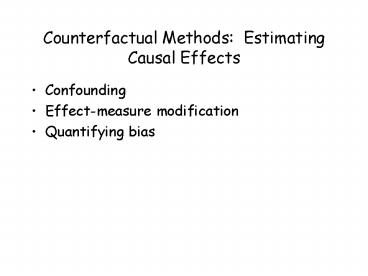Counterfactual Methods: Estimating Causal Effects - PowerPoint PPT Presentation
1 / 18
Title:
Counterfactual Methods: Estimating Causal Effects
Description:
If civilization is to survive, we must cultivate the science of human ... Question: Does fluoridation treatment reduce the incidence of dental caries? Target ... – PowerPoint PPT presentation
Number of Views:309
Avg rating:3.0/5.0
Title: Counterfactual Methods: Estimating Causal Effects
1
Counterfactual Methods Estimating Causal Effects
- Confounding
- Effect-measure modification
- Quantifying bias
2
- If civilization is to survive, we must cultivate
the science of human relationships -- the
ability of all peoples, of all kinds, to live
together, in the same world at peace.
Franklin D. Roosevelt - What we have to do... is to find a way to
celebrate our diversity and debate our
differences without fracturing our communities.
Hillary Rodham Clinton - Confounding
- Bias
- Effect-measure modification
- Interaction
3
Causal contrast - confounding
- Present if substitute imperfectly represents the
counterfactual - Association measure is confounded for a causal
contrast due to imperfect substitution
4
Causal contrast - confounding
- Scenario 1 (target experiences D1) confounding
occurs if - Magnitude of confounding
5
Causal contrast - confounding
- Scenario 2 (target experiences D0) confounding
occurs if - Magnitude of confounding
6
Causal contrast - confounding
- Scenario 3 (target experiences ? D1 or D0)
confounding occurs if either - Magnitude of confounding
7
Causal contrast - confounding
- Magnitude of confounding
- If in any of the scenarios where the direct
comparison is not equal (1,2) or the product (3)
does not equal one, the ratio association measure
(RRassociation) will be confounded for the causal
contrast (RRcontrast)
8
Causal contrast - confounding
- Control of confounding
- Often considering several variables at one while
keeping them distinct - Some measured, some not
- Relevant to which variables are controlled,
status as a confounder magnitude and direction
of confounding can change considerably - If balanced out, control of one may actually
lead to a greater order of magnitude of
confounding
9
Causal contrast - confounding
- Control of confounding
- Depends on creating strata within which the
no-confounding equalities are satisfied - Confounders
- Factors that explain or produce confounding
- Explains discrepancy between the counterfactual
(desired but unobservable) and the substitute
10
Causal contrast - confounding
- Example
- Question Does fluoridation treatment reduce the
incidence of dental caries? - Target
- Population children in a community
- Time period 3 years post-fluoridation treatment
of water supply - Counterfactual argument
- Substitute
11
Causal contrast - confounding
- Example
- Comparison of rate in year prior to fluoridation
(t0-1yr) to rate at three years after
fluoridation (t3) yields measure of effect or
measure of association? - Hint do component rates refer to same or
different population? - Confounding
- Does substitute rate equal rate had exposure not
occurred (counterfactual rate)?
12
Effect-measure modifier
- Any factor that modifies the size of a ratio
effect measure - Causal risk ratio varies from one population to
another or from one time period to another in the
same population - Consistency of risk ratio therefore not a valid
causal criterion
13
Causal Types
- Exposed Unexposed
- Type 1 No effect - doomed 1 1
- Type 2 Causative susceptible 1 0
- Type 3 Preventive susceptible 0 1
- Type 4 No effect - immune 0 0
- 0 no disease (unaffected) 1 disease
(affected) - Greenland Robins, IJE 15413-19, 1986
- from Miettinen, Scand J Work Environ Health,
121152-8, 1982
14
Effect-measure modification
- Why can the size of the causal effect for a given
pair of exposure distributions be different for
different targets? - Definitions
- Pdoomed proportion of individuals with disease
regardless of exposure - Pcausative proportion of individuals who get
disease if and only if exposed - Ppreventive proportion of individuals who get
disease if and only if not exposed
15
Effect-measure modification
- Proportion who get disease if exposed
- Pdoomed Pcausative
- Proportion who get disease if not exposed
- Pdoomed Ppreventive
- Causal risk ratio
16
Effect-measure modification
- Any factor affecting Pdoomed, Pcausative, or
Ppreventive can be an effect-measure modifier
(modifies the size of a ratio effect measure) - Causal risk difference not dependent on Pdoomed
- Therefore, only factors affecting proportions
susceptible to exposure can modify causal risk
difference
17
Quantification of effect-measure bias
- Measures of association are surrogates for causal
measures - How different are they?
- Understanding this is a critical step in study
interpretation - Formal evaluation (quantification) of bias
- Sensitivity analysis
- Validation substudies
18
Quantification of effect-measure bias
- Counterfactual approach
- RRexpected estimate
- RRcausal?biascounfound?biasf/uloss?biassampling?bi
asnonresponse?biasexclusion ?biasinfo - Result used in sensitivity analysis under
different plausible scenarios































